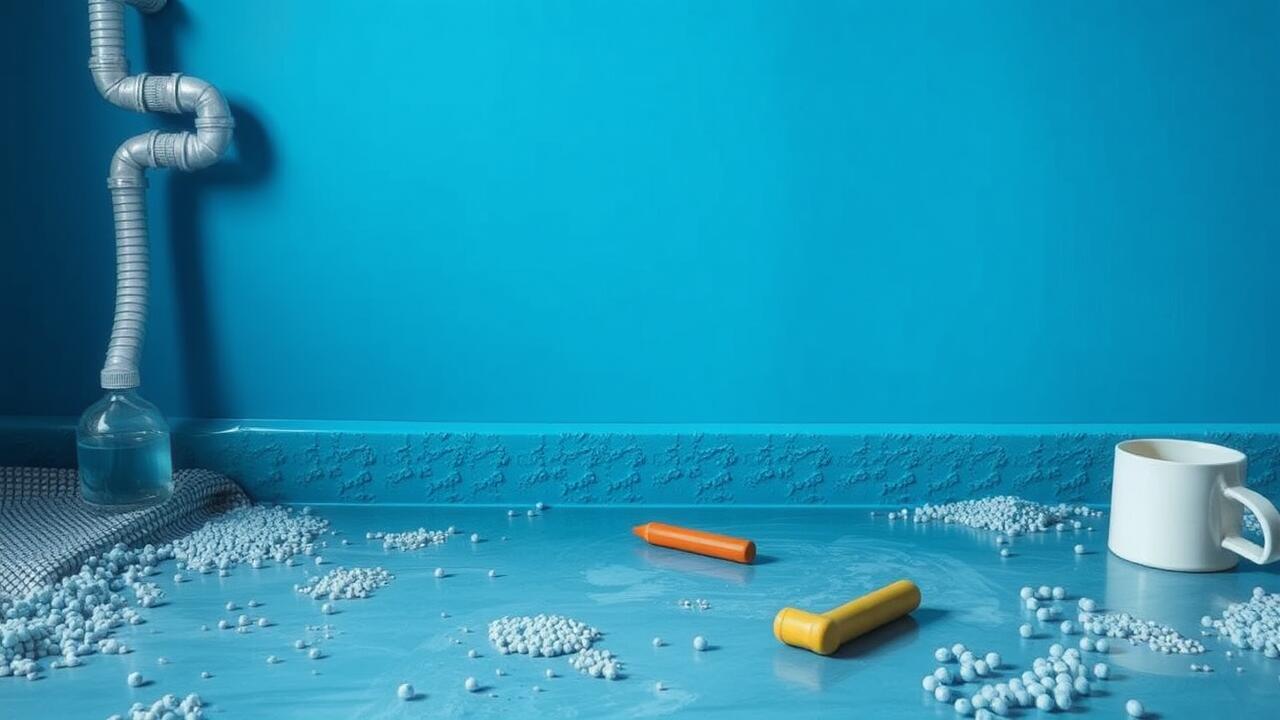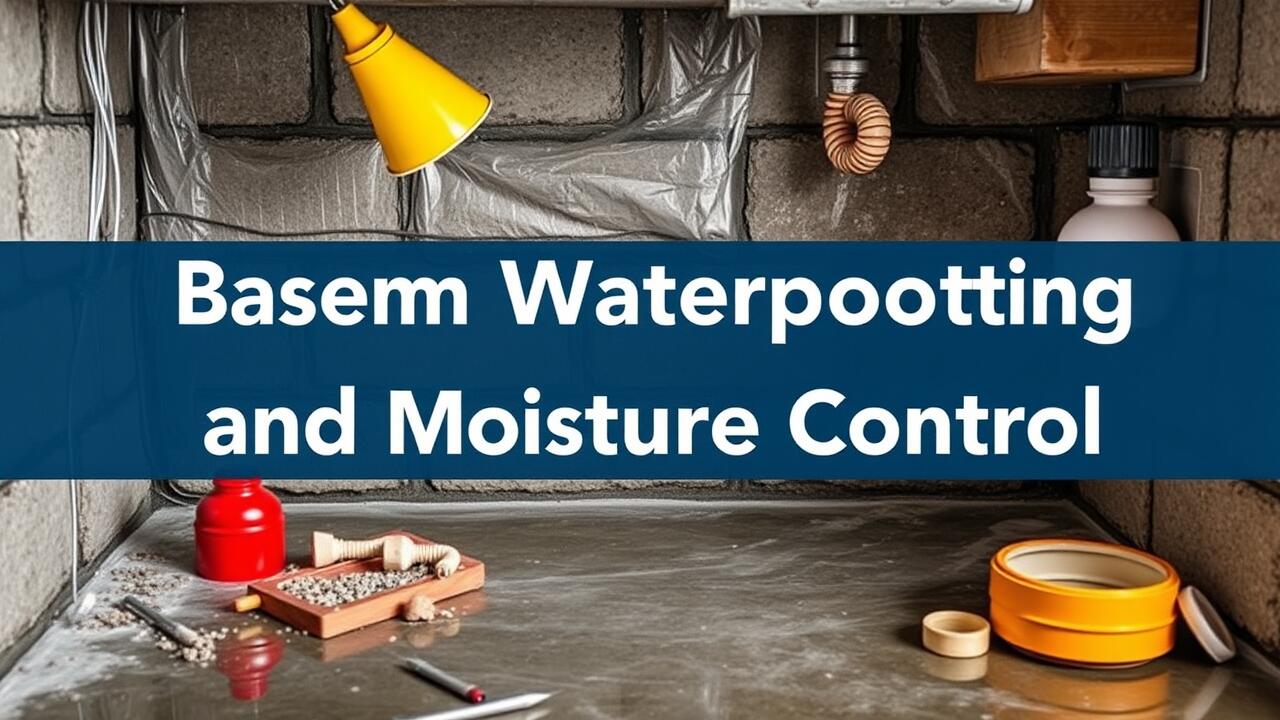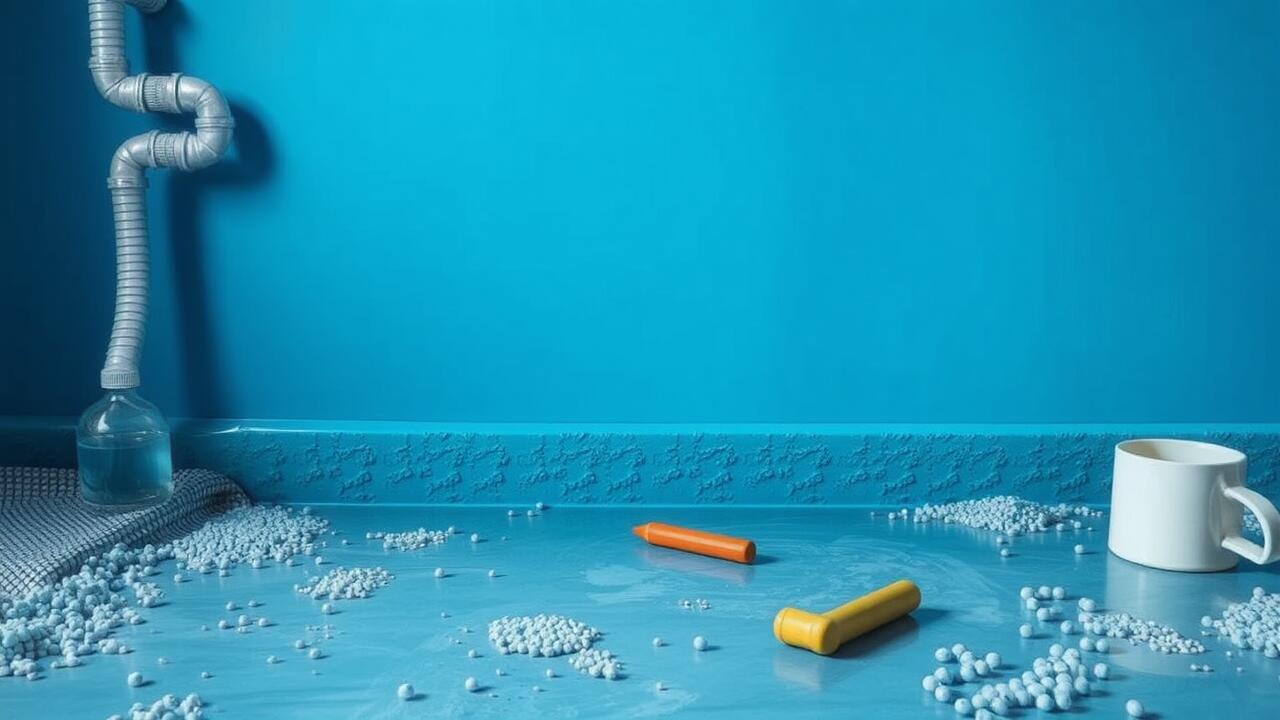Basement Waterproofing And Moisture Control | The Importance of Basement Waterproofing
Basement Waterproofing and Moisture Control are crucial for maintaining a healthy home environment. Without proper basement waterproofing, water leaking can lead to severe damage, including mold growth, wood rot, and structural issues. Waterproof membranes effectively create a watertight barrier that protects basements from ground-water infiltration. High humidity levels can exacerbate these problems, making humidity control a necessary aspect of moisture management. Installing drywall in a waterproofed basement can help safeguard against moisture damage. Ensuring that your home is equipped with the right waterproofing methods can significantly enhance the longevity and safety of your living space, preventing costly repairs and preserving the integrity of your property.

Basement Waterproofing and Moisture Control | Understanding Basement Moisture Issues
Basement moisture issues primarily stem from the interaction of rainwater and surface water with your home’s structure. High humidity can compound these problems, creating an environment ripe for water infiltration. An effective drainage system is essential for directing water away from the foundation. Without proper drainage, water damage may occur, leading to costly repairs. An airtight approach to basement waterproofing and moisture control is crucial for maintaining a dry environment.
Various sources contribute to basement moisture problems, including plumbing leaks and inadequate insulation. Implementing solutions like a trench drain can help manage excess water. Consistent humidity levels should be monitored to prevent mold and mildew growth. Understanding these moisture sources is essential for effective basement waterproofing and moisture control. Addressing these concerns early will safeguard your home against potential damage.
The Impact of Basement Water on Your Home
Basement water can severely compromise the structural integrity of a home. Foundation walls are vulnerable to liquid water intrusion, leading to cracks and mold growth. This dampness can also damage appliances like washers and clothes dryers, creating costly repairs. Implementing effective Basement Waterproofing and Moisture Control measures, including proper drainage channels and vapor barriers, is crucial. Without these precautions, humid air can accumulate, raising the risk of damp conditions that promote further moisture concerns.
Water pressure can build up around your home’s foundation, especially during heavy rainfall. A well-designed drainage system, including drywells and proper ventilation, is necessary to manage this excess water. Homes lacking sufficient drainage or humidifiers to regulate humidity levels may experience persistent moisture problems. Establishing effective ventilation and ensuring all drainage channels are functioning properly will help mitigate the risks associated with basement water.
Types of Basement Waterproofing
Basement waterproofing and moisture control are critical for maintaining a healthy and safe home environment. Common challenges such as flooding and the intrusion of groundwater can lead to significant damage, particularly in masonry walls. Effective solutions include both interior basement waterproofing techniques, like applying sealant, and exterior basement waterproofing methods that focus on preventing water from entering the structure. Ventilation systems play a vital role in managing humidity levels, especially in areas where clothes dryers and laundry facilities are located. Addressing basement moisture not only helps in avoiding flooded basements but also enhances overall basement moisture control, ensuring a more comfortable living space.
Interior Basement Waterproofing Techniques
Interior waterproofing techniques play a crucial role in managing typical basement moisture levels. Homeowners often face serious basement moisture problems that can lead to wet basements and compromised foundations. Effective basement waterproofing and moisture control solutions involve the use of interior drainage systems, sump pumps, and vapor barriers. These methods help mitigate basement water issues by redirecting incoming moisture away from the interior space. Addressing the basement moisture problem with proper interior waterproofing minimizes the risk of structural damage and health hazards associated with damp environments.
The implementation of interior waterproofing strategies is essential for tackling various basement water problems. Strategies such as sealants, drainage channels, and interior wall coatings can effectively reduce moisture penetration. It is important to identify specific basement water issues to determine the best approach to foundation waterproofing. These interior techniques are not only cost-effective but also provide a long-term solution to maintaining manageable basement moisture levels. Effective interior waterproofing ensures a dry and healthy living space, safeguarding against potential basement water problems that can arise over time.
Exterior Basement Waterproofing Solutions
Exterior waterproofing involves applying a comprehensive waterproofing system around the outside of your basement walls. This method effectively combats basement water seepage before it can cause issues within the foundation. A well-designed exterior moisture control system creates a barrier that directs water away from your home, ensuring a dry basement. Professional exterior waterproofing services can enhance the longevity of the structure while providing a level of moisture control that DIY waterproofing often cannot achieve.
Implementing effective moisture control measures is crucial for any homeowner. The waterguard basement system is a popular choice that helps to alleviate water buildup outside the foundation. By investing in professional exterior waterproofing, property owners can establish several moisture control strategies, reducing the risk of mold and structural damage. A dry basement not only enhances living conditions but also protects property value, reinforcing the importance of proper basement waterproofing and moisture control.
- Understand the importance of proper grading around your home to direct water away from the foundation.
- Consider installing a French drain system to channel excess water away from the basement walls.
- Regularly inspect and maintain gutters and downspouts to prevent overflow and water pooling near the foundation.
- Utilize vapor barriers in conjunction with exterior waterproofing to further reduce moisture penetration.
- Seek professional assessment to identify the best waterproofing solutions tailored to your property’s specific needs.
- Monitor for signs of existing water damage and address them promptly to avoid escalating issues.
- Educate yourself on local drainage regulations and best practices to ensure compliance and effectiveness.
Comprehensive Basement Moisture Control
A successful moisture control strategy is essential for maintaining a healthy living environment. Effective moisture management begins by addressing core issues that lead to foundation moisture problems, such as poor drainage and inadequate waterproofing. Implementing a proper basement drainage system can help prevent a flooded basement and ensure that water does not accumulate. Utilizing high-quality waterproofing products like Drycrete waterproofing and other masonry waterproofing products can significantly enhance your basement waterproofing and moisture control efforts. By creating a dryer basement interior, homeowners can mitigate the risks associated with a damp basement, ensuring that their foundation remains intact and protected from water infiltration. The waterproofing industry offers various solutions designed to tackle these challenges, making it crucial to choose the right method for lasting results.

Identifying Basement Moisture Sources
Understanding the sources of moisture in basement environments is crucial for effective moisture management. Common interior moisture sources include leaking pipes, humidity from laundry appliances, and even groundwater seeping through basement walls. If a leaky basement goes unaddressed, it can lead to more significant problems like flooded basements and mold growth. Applying a waterproof sealant or installing a moisture barrier can help mitigate these moisture issues, ensuring that your basement remains dry and safe.
Exterior waterproofing jobs are equally important in combating moisture sources from outside the home. Poor drainage systems and heavy rainfall can contribute to water accumulation around the foundation, leading to basement flooding. Employing effective waterproofing methods, such as waterproof coatings and a proper waterproof seal, helps protect your home from adverse effects. For homeowners considering basement waterproofing and moisture control, recognizing these potential sources is the first step in maintaining a dry, healthy living space.
Common Basement Moisture Problems
Basement moisture problems can manifest in various forms, leading to significant issues if left unaddressed. Damp basement smells often indicate moisture buildup, which can stem from ground moisture or basement wall leakage. Leaky basement walls are a common culprit, allowing water to seep in and create an unhealthy environment. Homeowners must recognize the importance of Basement Waterproofing and Moisture Control to mitigate these moisture-related concerns effectively.
Identifying and addressing moisture sources is crucial for maintaining a moisture-free and healthy basement environment. Problems such as moisture seeping through basement shower walls can contribute to an overall sense of dampness. Employing a waterproof barrier and working with accountable waterproofing contractors can help ensure proper basement dewatering and prevent future moisture problems. By taking proactive measures, homeowners can protect their basements from the damaging effects of moisture.
Effective Waterproofing Systems
Creating an effective system for Basement Waterproofing and Moisture Control requires a comprehensive understanding of both internal and external moisture sources. Many basement walls can be susceptible to moisture damage, particularly from accumulated moisture and moisture vapor. Implementing waterproof sealants on the basement floor and walls can significantly reduce the risk of moisture-related issues. It is crucial to monitor optimal moisture levels, as even a cool basement wall can become a breeding ground for mold if not properly managed. Integrating various basement systems tailored to address these challenges ensures a robust defense against moisture infiltration, ultimately preserving the integrity of the home.
- Regularly inspect and maintain gutters and downspouts to divert water away from the foundation.
- Install a sump pump to manage water accumulation in the basement efficiently.
- Utilize dehumidifiers to control humidity levels and prevent mold growth.
- Apply exterior waterproof coatings and membranes to prevent water penetration.
- Ensure proper grading around the foundation to direct water away from the home.
- Consider installing French drains to improve drainage around the basement.
- Use vapor barriers to minimize moisture transfer from soil to basement floors.
Choosing the Right Waterproofing Method
Selecting the appropriate waterproofing method is crucial for effective Basement Waterproofing and Moisture Control. Each technique addresses specific issues related to excess moisture in your basement space. Interior basement walls may require sealants to create a watertight barrier, especially in areas prone to internal moisture generation. Likewise, crawl space moisture can be managed with vapor barriers, ensuring that basement air remains dry and clear of humidity.
Exterior basement solutions play a vital role in preventing moisture infiltration from the outside. Effective drainage systems around basement windows and the foundation can redirect water away from the property. A combination of both interior and exterior methods often yields the best results, cultivating a resilient basement environment that minimizes moisture problems. A healthy basement not only preserves the structural integrity of your home but also supports a safe living space.
Integrating Interior and Exterior Waterproofing
A successful approach to Basement Waterproofing and Moisture Control involves a strategic combination of both interior and exterior solutions. Many basements suffer from moisture intrusion due to improper drainage systems or inadequate waterproofing. Implementing waterproof paints on basement interior walls can help mitigate uncontrolled moisture buildup. Utilizing a basement sump pump further enhances this protection by efficiently removing any water that does accumulate. Proper rainwater management outside the foundation is just as crucial, ensuring water does not pool near basement slabs and contribute to basement problems.
Integrating effective humidity control measures is essential for creating a moisture-free living space. Interior methods like vapor barriers beneath the basement floor slab can significantly reduce moisture permeation from the ground. On the exterior, proper grading and drainage solutions ensure that water flows away from the foundation. National waterproof members often recommend a dual approach for optimal results. The combined use of both interior treatments and exterior waterproofing strategies creates a comprehensive defense against moisture intrusion, ultimately leading to a healthier living environment.
Managing Basement Water Issues
Effective management of basement water issues hinges on a thorough understanding of moisture movement mechanisms. Internal moisture arises from various sources, including trapped water beneath the basement slab and external water penetration through faulty foundation drainage systems. Implementing Basement Waterproofing and Moisture Control strategies is crucial to mitigate these issues. An all-star basements approach combines both internal and external techniques, such as using a hidden drainage channel to capture water leaks and maintaining optimal indoor humidity levels with a basement dehumidifier. Sealing potential entry points with an airtight cover ensures that moisture is kept at bay. For homeowners seeking to address these challenges, all-star basements today offers comprehensive solutions that achieve effective water control and create a healthier living environment.
| Issue | Solution | Description |
|---|---|---|
| Trapped Water | Drainage Channel | A hidden drainage system captures water that leaks through the foundation. |
| High Humidity | Dehumidifier | A basement dehumidifier helps maintain optimal humidity levels and prevents mold growth. |
| Water Penetration | Airtight Sealing | Sealing entry points ensures that external moisture cannot infiltrate the basement. |
| Poor Foundation Drainage | Foundation Repair | Repairing faulty drainage systems enhances the effectiveness of waterproofing measures. |
Tips for Preventing Basement Water Infiltration
Preventing basement water infiltration is crucial for maintaining a dry environment and ensuring the integrity of your home. Implementing effective Basement Waterproofing and Moisture Control strategies can significantly reduce the chances of frequent water leaks. A well-designed below-grade drainage system is essential, as it works alongside foundation drainage systems to manage excess rainwater. Maintaining proper humidity levels through the use of interior drainage systems also plays a vital role. Ensuring that dryer vents are directed away from the foundation further minimizes the risk of moisture accumulation.
Regularly inspecting and maintaining your exterior drainage systems is key to preventing water damage. An effective exterior drainage system directs water away from your home, reducing the risk of high humidity levels inside. Installing proper foundation drainage can help manage any potential water sources, ensuring that any moisture is swiftly diverted. Utilizing interior drainage systems that complement exterior strategies enhances overall protection. Collectively, these measures create a robust defense against water infiltration and promote a healthier living space.
Conclusion
Effective Basement Waterproofing and Moisture Control is crucial for maintaining a healthy and secure living environment. Addressing issues such as wetter ground conditions and implementing both interior drainage and exterior drainage systems can significantly reduce moisture levels. Utilizing basement dehumidifiers alongside robust waterproofing strategies creates a comprehensive defense against water infiltration. Ensuring these systems work in harmony not only protects your home’s structure but also enhances the overall comfort and safety of your basement space. A proactive approach to moisture management will ultimately extend the life of your property and safeguard its value.
FAQS
What techniques are effective for interior waterproofing in basements to ensure proper moisture management?
Interior waterproofing is crucial for maintaining dry basements, as it involves implementing moisture control systems that effectively reduce humidity. One common technique is to use a hidden drainage channel to capture water from leaks, which helps manage internal moisture sources and prevents excessive moisture accumulation. For successful basement waterproofing, partnering with experts like U.S. Waterproofing can provide tailored solutions for effective water drainage and proper moisture management.
What are the benefits of effective basement waterproofing in basements to achieve a dry environment?
Effective basement waterproofing is crucial for maintaining dry basements. It uses a hidden drainage channel to capture water from leaks, which significantly reduces humidity levels and prevents water damage. This helps create a healthy space by ensuring that the basement stays dry and free of mold and other moisture-related issues.
How can homeowners benefit from implementing basement waterproofing in basements to maintain a basement dry?
Homeowners can benefit significantly from effective basement waterproofing in basements, as it helps to create a basement dry environment. This not only prevents water damage and mold growth but also enhances the overall structural integrity of the home and can improve indoor air quality.
What are some common signs that indicate the need for basement waterproofing in basements?
Homeowners should look for common signs such as water stains on walls, musty odors, mold growth, or puddles on the floor, as these indicate that basement waterproofing in basements may be necessary to prevent further moisture issues.
What steps should homeowners take to prepare for a basement waterproofing project in their basements?
Homeowners should start by assessing the current condition of their basements to identify any existing water damage or moisture issues. It’s important to clean the area, remove any furnishings, and ensure proper drainage around the property before beginning basement waterproofing. Additionally, researching various waterproofing methods and hiring a professional can further enhance the effectiveness of the waterproofing process in their basements.
How can homeowners ensure long-term effectiveness of basement waterproofing in their basements?
Homeowners can ensure long-term effectiveness of basement waterproofing in their basements by regularly inspecting for signs of moisture, maintaining gutters and drainage systems, and addressing any cracks or gaps in walls and floors promptly. Proper ventilation and humidity control also play crucial roles in sustaining the benefits of basement waterproofing in basements.
What options do homeowners have for improving basement waterproofing in their basements?
Homeowners can improve basement waterproofing in their basements by exploring several options, such as installing exterior drainage systems, using waterproof paint or sealants on walls, and adding sump pumps to manage any water that enters the space.
What is the importance of maintaining regular inspections for basement waterproofing in basements?
Regular inspections are crucial for ensuring the effectiveness of basement waterproofing in basements. They help identify potential issues early, allowing homeowners to address moisture problems before they develop into more significant concerns such as structural damage or mold growth. Maintaining these inspections can lead to a healthier living environment and prolong the life of the waterproofing system in place.
What are some innovative methods for enhancing basement waterproofing in challenging basements?
Homeowners can explore several innovative methods for enhancing basement waterproofing in challenging basements. These methods may include the installation of interior drainage systems, exterior waterproof membranes, and advanced sump pump systems to efficiently manage water intrusion and maintain a dry environment.
What are the key considerations for selecting a contractor for basement waterproofing in basements?
When selecting a contractor for basement waterproofing in basements, it’s essential to consider their experience, reputation, and the specific services they offer, along with customer reviews and their warranty policies. This ensures that you find a reliable professional who can effectively address your waterproofing needs.

